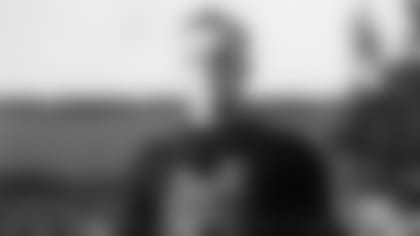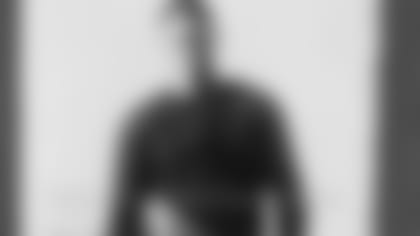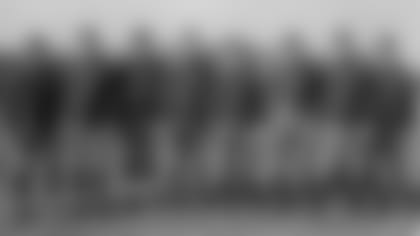(left to right) Eddie Anderson, Lawrence "Buck" Shaw, Jim Dooley, Fred "Ojay" Larson, Heartley "Hunk" Anderson, Harry "Horse" Mehre, Art "Hector" Garvey, Roger Kiley.
Credit: The University of Notre Dame Archives
Aside from the Jackie Robinson saga, which was really part of a much larger and more profound epic about American society, the story of the Green Bay Packers is the most compelling in sports.
No novelist, no Hollywood producer could have dreamed up a better narrative. The Packers' improbable survival and success in the only pocket-sized outpost in big-time sports is living proof that truth is stranger than fiction.
But, sadly, Packers history has to be one of the most poorly researched subjects on sports bookshelves and there's no better example of that than the story about the Packers getting kicked out of the American Professional Football Association, just months before it was renamed the National Football League.
Yes, the Packers, who are nearing their 100th year in the NFL, almost didn't survive six months.
At a league meeting on Jan. 28, 1922, at the Courtland Hotel in Canton, Ohio, J. Emmett Clair, who had run the Green Bay franchise with his brother John Clair during the 1921 season, offered to withdraw it following a discussion with other club owners, according to the league minutes on file at the Ralph Wilson Jr. Pro Football Research and Preservation Center at the Pro Football Hall of Fame.
The Packers had been caught using college athletes with eligibility remaining under assumed names. Clair apologized for the indiscretion and his offer to withdraw from the league carried. While it wasn't noted in the league minutes, the players were from the University of Notre Dame.
Sixty-five years later, the book, "The History of the Green Bay Packers: The Lambeau Years Part One," concluded the following.
1) The Packers used the players against the Decatur Staleys (now the Chicago Bears but even then the Chicago Staleys) in a game played on Nov. 27, 1921.
2) The* Chicago Tribune *was the source of the story and where Notre Dame coach Knute Rockne learned about it.
3) George Halas "was the man behind the expulsion" of the Packers and (NFL president) Joe Carr "aided and abetted the Halas plot." Further, Halas "was the author of all the articles" about the Staleys appearing in the Chicago papers in 1921 and worked in concert with the Tribune to oust the Packers from the league.
This conspiracy theory, hatched over nearly 13 pages, has been repeated in countless other books and articles about the history of the Packers and the NFL, although it was unsupported by official documents and newspaper stories of the day.
Let's start by working backwards.
Handwritten minutes of a Faculty Board of Athletics meeting dated Dec. 9, 1921, are on file at the University of Notre Dame Archives. In the second paragraph, it was noted, "information had arrived Friday noon that four Notre Dame stars had played professional ball on the Sunday immediately preceding."
The minutes, dated four days prior to the story breaking in both the South Bend Tribune and Chicago Tribune, didn't name the players, but noted all members of the board were present except for Rockne and two priests.

Soon thereafter, The Notre Dame Scholastic, the university's student news magazine, reported, "Three of the ablest of our players – Heartley Anderson (pictured right), Fred Larson and A.A. Garvey – were found guilty of having played professional football in the city of Milwaukee."
The Scholastic* *added, "They have been barred from participation in athletics at Notre Dame and their monograms have been withdrawn." Larson and Garvey were juniors; Anderson was a senior and recently had been elected captain of the hockey team.
The South Bend paper ran a detailed front-page story on Dec. 13, 1921, and reported the athletic board's final decision was reached following additional conferences on Saturday and Monday. In addition, it reported the expelled players had played for the Packers on Dec. 4, at Milwaukee, against an American Legion team.
The Chicago Tribune also reported on the board's action for the first time on Tuesday, Dec. 13, but in a much briefer six-paragraph story under a one-line subhead in the sports pages.
The Packers' opponent on Dec. 4 was the Racine Legion, a non-league foe that would be admitted to the NFL before the 1922 season. The game had been promoted as a showdown for the state championship and played at Milwaukee's minor league baseball park, later renamed Borchert Field.
While news traveled considerably slower if at all in those days and college players performing on Sundays on the sly to pick up extra cash was commonplace, it was no secret in Milwaukee and Racine that the Legion was loading up for the game.
Newspapers in both cities reported beforehand that Notre Dame stars John Mohardt and Eddie Anderson, both seniors, were going to play for Racine. Both had starred for Notre Dame two weeks earlier in its victory over Marquette at Milwaukee and their return engagement figured to draw more fans to the pro game.
The Racine-Green Bay game lived up to its billing, ending in a 3-3 tie.
What's more, the Racine Journal-News divulged in its game story the next day that Green Bay also had fortified its lineup with ringers.

"Green Bay had several Notre Dame men from this year's lineup with her," wrote Jack Roberts of the Journal-News. "They were Larson (pictured left) at center; (Buck) Shaw at left guard, and Anderson at left tackle."
The Green Bay Press-Gazette in its Dec. 5 edition included in its lineup of Packers starters: Smith at center, Keefe at left guard and Oakes at right tackle. It also listed Williams as the quarterback and Sullivan as the right guard.
Two Milwaukee papers, the Sentinel and Journal, listed Sullivan as the left tackle, Oakes as the left guard and Clancy as the center.
Players named Oakes, Williams, Sullivan and Clancy had not played in the Packers' six league games or previous four non-league games that season.
Could it be that the Packers also used college underclassmen in their game against the Staleys a week earlier?
No mention of it could be found in any of the newspapers of the day or any official documents at Notre Dame and the Pro Football Hall of Fame's research center. There also was nothing suspicious about the names listed in the Packers' lineup.
In 1956, Jack Rudolph was a Press-Gazette colleague of Packers co-founder George Whitney Calhoun, who had covered the games in both Chicago and Milwaukee 35 years earlier, and wrote the following about what continues to be recognized as the first Packers-Bears game.
"Several other Packers (in addition to an injured Tubby Howard) didn't appear either. The roster included a number of college players under assumed names and when word got around the dressing room just before game time that a number of college representatives would be in the stands they refused to take a chance on their eligibility."
Keep in mind the Packers' roster was a revolving door in 1921 as they replaced their local players, mostly products of Green Bay's East and West high schools, with recruits who had played college football, mostly at Notre Dame and other Midwest schools.
Thus, by the end of the season, the Packers had so many players living in or near enough to Chicago they had to practice there. Before the Packers' final two league games, against the Cardinals and Staleys, they didn't practice until Friday, or after they arrived in Chicago.
So even though there's not a shred of evidence, much less any proof, of the Packers using still-eligible players from Notre Dame against the Staleys, nothing can be ruled out. Then again, to concoct or repeat a conspiracy theory around that game surely qualifies as journalistic negligence based on the paper trail of primary sources available at so many libraries.
Did Halas and the Chicago Tribune collaborate to get the Packers kicked out of the league?
Rockne, who doubled as Notre Dame's athletic director, lashed out at pro football the day after the scandal story broke and called on college coaches to take a stand against the pros. "College Football Faces Most Serious Crisis In History" and "Rockne Points To Evil," were two of the subheads over the South Bend Tribune's Page 1 story.
This time, the Chicago Tribune waited an extra day, running a much shorter story about Rockne's reaction on Dec. 15.
In the same edition, in his "Straight From The Shoulder" column, the Chicago Tribune's Frank Smith called on pro football to banish the Packers. When the league did just that six weeks later, the paper praised the decision and boasted it was "the direct result of an expose by The Tribune* *of conditions prevailing on the Green Bay team."
The minutes of the Jan. 28, 1922, APFA meeting show that Halas moved to accept Green Bay's withdrawal.

It also was true Walter Halas, George's older brother, was an assistant coach to Rockne at Notre Dame, and George Halas coveted Anderson, Larson and Garvey (pictured right) enough to have signed them for the 1922 season.
It's all there in writing.
The Chicago Tribune lobbied to get the Packers booted out of the league and Halas favored their withdrawal. However, there is no evidence they conspired with each other. Moreover, the Tribune* *might have patted itself on the back for breaking the story, but papers in Racine and South Bend actually beat it to the punch.
Smith's appeal to Carr and the rest of the league was a typical, passionate sports column. In essence, he was repeating what many of college football's most prominent coaches were preaching: The pros were ruining their sport.
Smith's column wasn't particularly kind to pro football in general and it certainly wasn't a screed directed at the Packers. There's more. Smith was the Tribune's* *sports editor, not someone likely to ask a 26-year old Halas to ghostwrite his column.
Finally, Smith wasn't alone. J.J. Delany of the Milwaukee Sentinel criticized the three Notre Dame players for taking money to play against Racine and also endorsed Smith's position.
Two days after Smith's column appeared in the Tribune, Delany wrote in his "The Morning After" column, "Professional football, the minute it starts tampering with college players deserves no support from the public…"
Let's not forget, Rockne was much more of a national figure at that point than Halas. Moreover, college football was where the crowds and the money were, and there might have been no bigger hotbed of the sport than Illinois. Those were the days when the University of Chicago under legendary coach Amos Alonzo Stagg was a national power and covered accordingly.
It also should be noted the morning of the APFA league meeting, when Green Bay lost its franchise, the Tribune, via The Associated Press, broke an even bigger scandal on its front page over a semipro game played between two small Illinois towns, Taylorville and Carlinville.
"The bitter rivalry between the two country towns" was "so acute that approximately $100,000 was bet on a football game," AP* *reported.
The two towns had loaded up with ringers, nine players from the University of Illinois on Taylorville, and at least eight from Notre Dame on Carlinville, for a game played on Nov. 27, 1921, the same day as the Packers-Staleys game.
Although the book subtitled "The Lambeau Years Part One" suggests Rockne learned of this double dose of bad news at virtually the same time, the Tribune first reported on the Taylorville-Carlinville scandal 46 days after it first disclosed the Packers' misdeeds.
Clearly, as the APFA owners gathered in Canton, pro football was under intense pressure to clean up its act and making an example of Green Bay, a league city, was a convenient recourse.
Halas also had his own problems to worry about at the meeting. He was athletic director of the Staley Manufacturing Co. of Decatur, Ill., in 1921, and running the Staleys in partnership with Ed "Dutch" Sternaman and supposedly Bill Harley. By the Canton meeting, Halas and Sternaman were in a battle with Harley over ownership of the franchise. The league minutes reflect three representatives from the Staleys were at the meeting and their dispute was "thoroughly discussed."
During the proceedings, the league's executive committee also requested a statement of fact from Halas, Harley and A.E. Staley, the Decatur starch-maker and original sponsor of the franchise.
It wasn't until after Green Bay lost its franchise that Halas and Sternaman finally prevailed by six votes and were awarded one in the name of the Chicago Bears.
One book which got the story right, including the role of the Packers-Racine game, was "Joe F. Carr: The Man Who Built The National Football League." Author Chris Willis, head of the research library at NFL Films, also debunked the theory Halas was the driving force behind the Packers' ouster, just so he could sign Hunk Anderson and two other players. "Sounds too far-fetched" to believe was Willis' conclusion.
Admittedly, Halas probably saw little value in retaining Green Bay as a league member at that point. The two teams had played one game and Halas had yet to reap the financial bonanzas that he would later from the rivalry.
Then again, he didn't appear to have much of any influence on the Tribune, contrary to what was written. Advance stories of Staleys games were no more than two paragraphs long at times and game stories no more than six in accordance with pro football's minor-league standing at that point. Also, Halas had entered into an agreement in early December 1921 to write offseason basketball stories for a Tribune competitor, the Chicago Daily Journal.
As it turned out, the league wasn't very serious about making an example of Green Bay, either. On June 24, 1922, less than five months later, Green Bay was readmitted.
Special thanks to those responsible for gathering and overseeing the extensive collections at the University of Notre Dame Archives at the Hesburgh Library, the Brown County Library Local History and Genealogy Dept. in Green Bay, the Wisconsin Historical Society Library, the Ralph Wilson, Jr. Pro Football Research and Preservation Center at the Pro Football Hall of Fame and the St. Joseph County Public Library in South Bend, Ind.
- *















